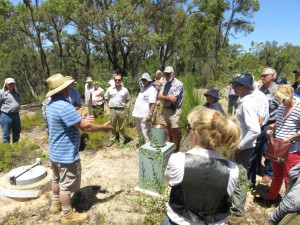Wetlands are wonderful and not just because they play important roles in providing ecosystem services that keep our landscapes healthy and productive.
Wetlands support industries such as agriculture, fisheries, forestry and tourism – by supplying water for crops, stock and people; helping maintain water quality, providing habitat for commercial as well as native species, and providing cultural and recreational values.
For all of these reasons, and more, a group of community members recently joined the Northern Agricultural Catchments Council (NACC) team, along with staff from the Department of Water, and Gingin Water Group members for a tour of some of the diverse waterways around Gingin.
 Held on World Wetlands Day, 2 February, the event brought together a cross-section of the community to discuss, debate and celebrate the significance of local waterways to the social, environmental and economic fabric of the area.
Held on World Wetlands Day, 2 February, the event brought together a cross-section of the community to discuss, debate and celebrate the significance of local waterways to the social, environmental and economic fabric of the area.
Travelling by bus, the tour group first convened at the headwaters of the Gingin Brook where local landholder Geoff Overheu treated participants to incredible views of the upper catchment and a history of his family’s land management goals and practices.
“I feel incredibly privileged to own this farm,” he said, “and feel it is a moral obligation for all landholders to protect the brook system.”
From there, the group wound their way down through the catchment, viewing the main waterway and side tributaries, as well as the diverse agricultural systems throughout the catchment.
Expert commentary of the brook system was delivered by long-time local driller George Grant which was appreciated by all. David Rickson, Chairman of the Gingin Water Group explained the interconnection of the wetland systems, and the importance of community feedback and monitoring to decision-makers both inside and outside the community for best wetland management.
Mike Johnson and Tim Storer from the Department of Water sampled a few sites for macroinvertebrates, and explained the monitoring techniques used by the Department when sampling a wetland.
Over lunch at the Grant’s farm, participants heard from presenters and local community members about the brook system, the need for further monitoring, and actions to improve its health. Lidia Boniecka, from the Department of Water, gave an insight to the waterway flow monitoring work that she has undertaken in recent years.
After lunch, the group visited Chitna Pool, the Bookine Bookine Gauging Station and its fish ladder, and the confluence of the Gingin Brook and Moore River at Neergabby.
NACC expresses its thanks to all attendees and speakers on the day, to the landholders who allowed us to visit their properties, and to the Department of Water and the Gingin Water Group for their contributions towards making the day such a success.
For more information about the Gingin Brook waterways and the opportunity to be involved in the monitoring project, visit the Gingin Water Group website.







